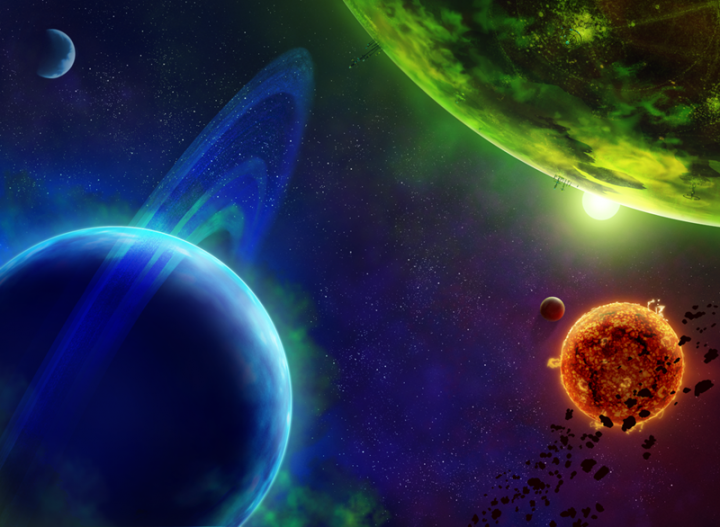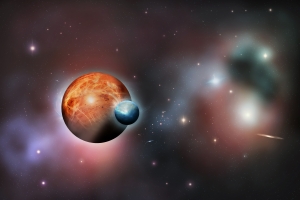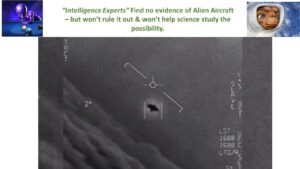 Science fiction is a world of ideas. That’s why we allow its practitioners such leeway in the quality of their prose. It is rather hard to be a man of ideas and a prose stylist – it’s rather like a metrosexual engineer – a rare breed. When you throw in a translation, from Polish for example, you don’t know what is interpretation and what is original, another reason for leeway. With that said, the prose in this 1961 sci-fi classic is fairly representative of the mediocrity of the genre. There’s an over reliance on the passive voice, cumbersome prepositional phrases when adjectives would suffice and generally, for lack of a better word, plastic prose, again, expected of the scientific mind, the geek, the idea man.
Science fiction is a world of ideas. That’s why we allow its practitioners such leeway in the quality of their prose. It is rather hard to be a man of ideas and a prose stylist – it’s rather like a metrosexual engineer – a rare breed. When you throw in a translation, from Polish for example, you don’t know what is interpretation and what is original, another reason for leeway. With that said, the prose in this 1961 sci-fi classic is fairly representative of the mediocrity of the genre. There’s an over reliance on the passive voice, cumbersome prepositional phrases when adjectives would suffice and generally, for lack of a better word, plastic prose, again, expected of the scientific mind, the geek, the idea man.
How many high school kids are equally adept at Math and English? Not many, and Lem’s translated prose fits right in the wheelhouse with Asimov and Heinlein, icons of the genre, while falling short of the nostalgist, Mr. Bradbury. Sometimes though, the prose flows rhythmically and even bits of poetry appear. Describing a scientist whose work he was pursuing, the protagonist says, “Normally he had all the boldness of an ant crawling up a glacier”. Great imagery. But who cares, you may be wondering; sci-fi readers don’t notice such things, that’s for the effete Truman Capote stylists of the world, and you’re right, but what about science?
Lem knows his 1960’s science, he’s right in the thick of it and some of it holds up pretty well, and although there are no Einstein’s in the last 50 years, we’ve learned a few things via technology if not our imaginations. Lem speculates of many earth-like planets and we are now in full pursuit of these but thus far we’ve had little luck finding them. He speaks of a neutrino structure as the basis of an inexplicable creative capacity and this is bleeding edge 1960 as they knew not of muons, gluons, the boson particle and others of the latest and greatest atomic subdivisions. In another speculative moment, he declares humans as the first species endowed with reason and we now know this to be untrue; monkeys, apes, elephants, octopi, birds- all use tools and learn – the distinction with ourselves only one of degree. Finally, one character states that only two percent of mental processes are conscious – an interesting supposition for which I haven’t yet heard an answer from science.
All this doesn’t detract from the crux of the novel but it does reveal a drawback of relying on current science – it’s quickly dated. It’s quite hard for any literary work to remain contemporary yet the greatest works do somehow. With the exception of a lantern reference, one couldn’t tell if Poe’s “Tell Tale Heart” was written 200 years ago or last week and likewise in all of Shakespeare, the power remains whether artifacts are modernized or not. Lem’s far out 1960’s speculations remain relevant today.
In addition to bleeding edge science, Lem entertains philosophical questions. I believe I’ve heard this quote before and it’s a compelling one. “The fate of a single man can be rich with significance, that of a few hundred less so, but the history of thousands of millions of men does not mean anything at all, in any adequate sense of the word.” This is a musing of the narrator and somehow it rings true. This is easily understood by a soloist – leaving a hectic and teeming planet earth behind – as he soars into the heavens. One could review this novel based on its philosophical musings alone but I’ll leave that to the Ivory tower. Suffice it to say that Lem is interested not only in the how but the why.
Yet I digress, bottom line, Lem knows and likes his science and wallows comfortably in a soup of wisdom, he’s not one of these foo-foo namby-pamby sci-fi writers who throws in supernatural nonsense. He sticks to the rigors of the canon and for this we indeed salute. Now, on to the roux of the review.
 The novel starts with a descriptive descent onto the planet Solaris. It’s filled with a superfluity of scientific details which for some may be a bit too much. I’m the sort of reader, when images aren’t spontaneously generating, who must verbally construct them; Ok, metallic panel above, fluttering stars outside the vessel, feeling of vertigo – check, check, check, I must engineer which is tedious. I was thinking; Ok get on with it, land or something for Christmas’ sake. But of course, this may be just me; a nerd from a technical institute for example, may get a full left-brained binary visualization which excites him to a nose spewing grunt, but sadly, I’m not one of those. I was happy when he landed.
The novel starts with a descriptive descent onto the planet Solaris. It’s filled with a superfluity of scientific details which for some may be a bit too much. I’m the sort of reader, when images aren’t spontaneously generating, who must verbally construct them; Ok, metallic panel above, fluttering stars outside the vessel, feeling of vertigo – check, check, check, I must engineer which is tedious. I was thinking; Ok get on with it, land or something for Christmas’ sake. But of course, this may be just me; a nerd from a technical institute for example, may get a full left-brained binary visualization which excites him to a nose spewing grunt, but sadly, I’m not one of those. I was happy when he landed.
The protagonist is a psychologist named Kris Kelvin and when he arrives on the planet, its inhabitant’s number three, at least according to his itinerary. He first meets Dr. Snow – a grizzled, broken and confused old man who offers nothing but non-answers and obfuscations. Kelvin hammers him verbally but gets nowhere and ends up slamming the door in his face. Another fellow named Sartorius makes one cameo appearance during an experiment – he’s presented as an imperious old know-it-all (think Vincent Price in an old movie) and that’s the extent of his dramatic contribution. The third fellow, Gibrarian, well, he’s lying on a slab in cold storage. More on that later. Character development is not a strength of the novel.
The premise is this – and a bizarre one it undoubtedly is – the planet Solaris is comprised of a mysterious thinking, feeling, creating megalith of an ocean. Its inner workings are inexplicable although a surfeit of scientists have studied it for decades – it’s as unfathomable as the depths of the human mind and Lem cleverly makes this analogy. Years of study have yielded nothing but theories, statistics and camps. Many from the highest Academies wish to abandon the project but three diehards remain and they aren’t communicating. Kelvin is here to see what is going on.
But the sea, my gosh, we must revel in the sea. It creates colorful monoliths, exploding mountains, oscillating complexities beyond the wildest imaginations of human beings. The scientists have named and organized several of these amazing features based on a set of similar creative principles. But once a giant, lego-like edifice is complete, it quickly evaporates, transforming into something else entirely – perhaps equally impressive – or it dissolves into thick yellow foam. The sea is a viscous mixture, nothing like water, and it seems to create solely for the joy of creating. It’s not even opposed to producing giant, floating human like shapes resembling babies or men or whatever it can fabricate from the subconscious of those who have visited. It’s a living entity of mind-boggling creativity, an impermeable descendent of two symbiotic suns, an emphatically non-human imagination agent. It is our murky main character.
Shortly after the frustrating meeting with Dr. Snow, Kelvin sees a giant, black Amazon Queen roaming a hallway and he thinks he’s going mad. But his madness is held in check as soon thereafter, his deceased former wife appears. Rheya is her name and perhaps unlike the real-life version, she aims to please. It is now evident that this world somehow raids the subliminal mind to make manifest a person of endearment. This seems great at first but there’s something not right about these prototypes. This explains Snow’s initial reticence when he first sees Kelvin – is he real or another product of my mind?
 We quickly realize that companion replacement is mostly a curse, it certainly is to the men who’ve dealt with it for some time but Kelvin feels differently. He becomes re-attached to his former spouse although he’s in a constant state of anxiety as the purpose remains a mystery. He and Snow conspire to find out via plots, plans, procedures and protocols. Rheya gets wind of this and begins her own journey into intense introspection – as she has no idea who she is or why she’s here either. The great irony of the novel is that she is arguably the most developed character. She follows, discusses, contrives, plots and sulks. She does everything possible to help Kelvin figure out the situation and to make him happy. Her movements, beauty, garments and sunlit silhouettes are detailed as no other. She’s one heck of a gal for a prototype. The third scientist must not be as fond of his resurrected companion; in fact, she’s driven him to suicide. This is the cold corpse called Gibrarian and his character development consists of references to his work. He’s more like an index. In an eerie scene, Kelvin discovers him in a bunkered freezer with the black Queen at his side.
We quickly realize that companion replacement is mostly a curse, it certainly is to the men who’ve dealt with it for some time but Kelvin feels differently. He becomes re-attached to his former spouse although he’s in a constant state of anxiety as the purpose remains a mystery. He and Snow conspire to find out via plots, plans, procedures and protocols. Rheya gets wind of this and begins her own journey into intense introspection – as she has no idea who she is or why she’s here either. The great irony of the novel is that she is arguably the most developed character. She follows, discusses, contrives, plots and sulks. She does everything possible to help Kelvin figure out the situation and to make him happy. Her movements, beauty, garments and sunlit silhouettes are detailed as no other. She’s one heck of a gal for a prototype. The third scientist must not be as fond of his resurrected companion; in fact, she’s driven him to suicide. This is the cold corpse called Gibrarian and his character development consists of references to his work. He’s more like an index. In an eerie scene, Kelvin discovers him in a bunkered freezer with the black Queen at his side.
Kelvin’s newfound company becomes a dominant theme of the novel. He knows she can’t be real but why does she seem so? Why have they or it created her? The scientists even get together and analyze her cells under a microscope. Here Lem jumps on his preferred hot neutrino theory. It doesn’t get them far but scientists must do science. In fact, many experiments, calculations and theories are propounded throughout on the nature of the strange ocean and the unwelcome proto-humans. Nothing yields anything of value. At one point the authoritative Sartorius hooks Kelvin up to a contraption meant to beam x-rays of his subconscious mind into the depths of the ocean. They want to see if they can force creation out of the globular miasma. Again, no results whatever.
I have not yet watched the two movies based on the book but I’m anxious to see how the directors tackle the morphing, rolling sea – this would be the greatest of challenges, even with the tools of current CGI technology. The gyrations of the ocean could be an action-adventure in itself. I wonder what Lem thought of sci-fi films? Not much I would guess.
Near the end of the novel Snow and Kelvin have the “god” discussion. They dismiss traditional religions swiftly (like all good scientists) and delve into a pantheistic chat; no surprise given the nature of the mysterious and evasive living ocean that confounds them. Here we see a mature Lem philosophy born of knowledge of the universe rather than of the fanciful scriptures of man. He sees the universe as all we have – an unknowable mystery – and a far from perfect one at that.
Later, still in a philosophical mood, Kelvin makes a solo trip to the ocean surface. He stubbornly sticks to the idea that he may learn something. The massive sea performs a few parlor tricks for him as he probes, muses, analyzes, and surmises – yet the ocean remains taciturn. He feels its magnificent power up close, admires its ingenuity, is awed by its vastness, yet he knows it’s as concerned with him as an elephant with a flea.
There is no denouement; the three men continue their experiments, their science, and their calculations. Rheya is gone forever via a collaboration with Snow. The two come up with a successful vanishing act. Kelvin objects vehemently but realizes the inevitability of the deed although he secretly longs for her return.
Solaris remains an outpost; a Wild West inhabited by three mad scientists on a fool’s mission. Few care back on earth.
Perhaps someday the bizarre, mutating, magnificent sea will reveal itself –but then again, maybe it won’t.
_________________________________________________________________





TJ
3 Apr 2012What’s your favorite science fiction book or movie?
David
3 Apr 2012H.G. Wells’ “The Island of Doctor Moreau”
Aimee
3 Apr 2012Dune. The book I’ve read over 100 times and the movie I can talk along with. My all-time favorite.
Doni
3 Apr 2012Douglas Adams, Hitch Hikers Guide to the Galaxy for a book. Original Star Trek movie.
Jacqueline
3 Apr 2012Stargate (1994 movie, NOT the tv series)… Books… Hm. Tricky.
Daric
3 Apr 2012Robert Heinlein : Stranger in a Strange Land
Linda
3 Apr 2012Time Enough For Love by Robert Heinlein
Dan
3 Apr 2012The Bible
James
3 Apr 2012stranger in a strange land/dune series…tie.
Diane
3 Apr 2012Stranger in a strange land by Robert Heinlein and ALL of the Dragon Riders of Pern series by Ann McGaffery
Lena
3 Apr 2012”Picture of Dorian Gray” Oscar Wilde !
Jasper
3 Apr 2012Bookwise Peter F. Hamilton or Iain M. Banks. Movie…12 Monkeys. And The Hitchhikers Guide of course!
Al
3 Apr 2012Hitch hiker’s, journey to the centre of the earth and the time machine for me :0)
Ruth
3 Apr 2012Book: Dreamsnake; Movie: Forbidden Planet
Ami
3 Apr 2012”The Sirens of Titan” by the lovely Kurt Vonnegut!
Garry
3 Apr 2012Not to sound cliche’ but the Star Wars Universe… XD
Jon
3 Apr 2012Frank Herbert: the original Dune Series.
Dan
3 Apr 2012The Hickhikers “Trilogy”
Carol
3 Apr 2012Book: The Ender Series by Orson Scott Card. Movie: Serenity.
Pingback: The Sociopath Next Door – by Martha Stout Ph. D.